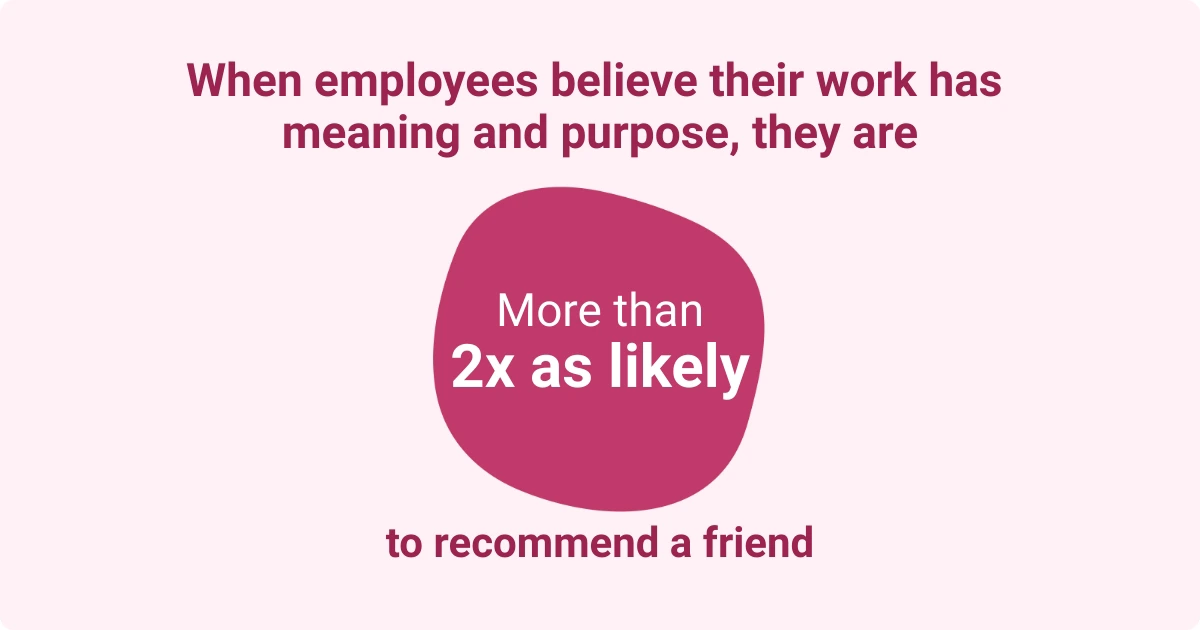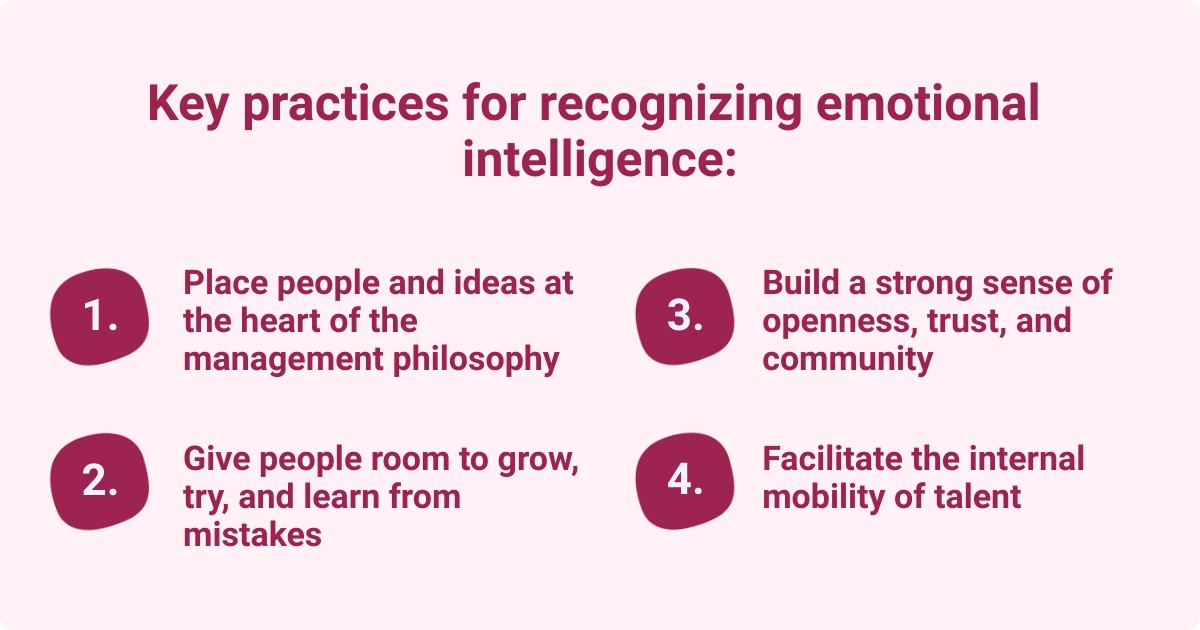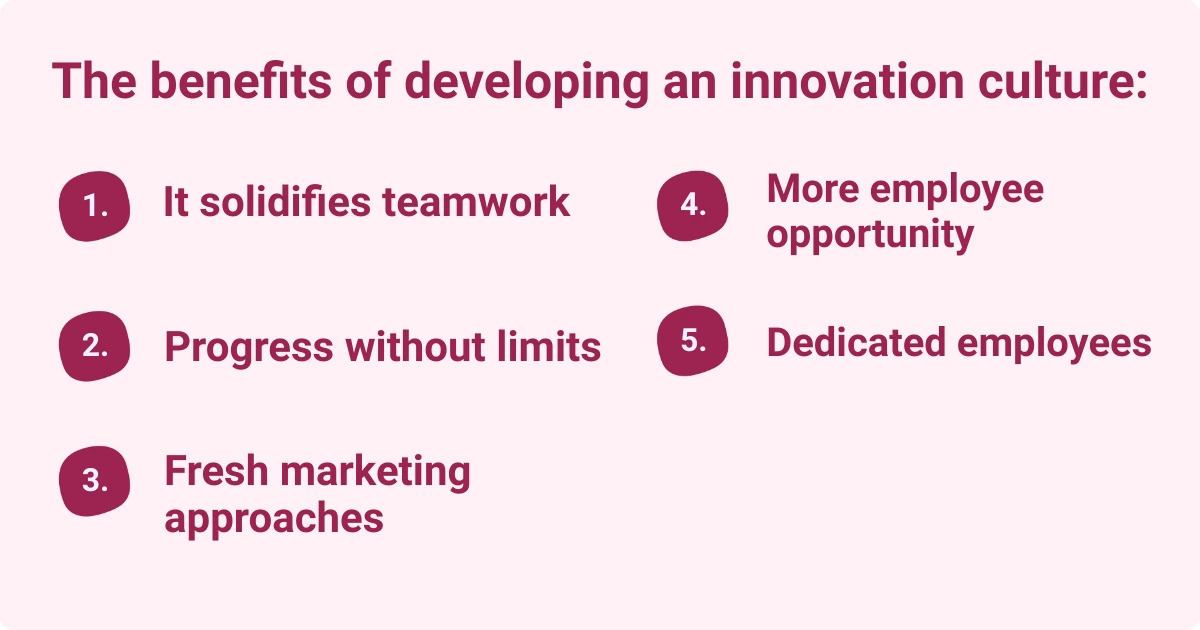Creating a Culture of Innovation: Key Characteristics and Strategies You Can Model
Table of contents
- What is innovation culture, and why is it important?
- What are the key characteristics of innovation culture?
- Six strategies for creating a culture of innovation in the workplace
- The benefits of developing an innovation culture
- What an establishment without a culture of innovation looks like
- Overcoming the most common barriers to innovation in companies
- What companies have built effective workplace environments for innovation?
- Takeaway

We have all found ourselves in a rut before. Whether it's because the ideas just aren't coming, you're procrastinating, or you're too overwhelmed with the day-to-day of life to think of anything, this block can be hard to push aside.
Those same dilemmas can happen to organizations, too. So, how do you bring your culture to life with new and creative ideas?
That's exactly what this guide aims to answer. We'll cover what creating a culture of innovation looks like in 2024, focusing on the key characteristics, how it works, and how to establish it within your company, all while reaping the benefits it provides.
What is innovation culture, and why is it important?
Innovation culture is comprised of social norms, patternsOpens in a new tab, and shared behaviors from employees at an organization that allows ideas and creativity to thrive within it.
For many, innovation means something different and new. However, you shouldn't restrict innovation solely to creativity but rather revolutionary ideas that hold and produce great value.
Not all ideas have to be new from scratch. They can be existing methods used in a fresh and unorthodox way. Innovation is asking yourself: How can I improve something I’ve previously done, and would it be useful now?
Cultural innovation nurtures ground-breaking thinking to spur ideas that break cultural barriers – being brave enough to defy the status quo for long-term company survival.
In our current society, putting people first is a delicate topic and even more fragile when one suggests breaking its barriers. However, as business leaders, it's important that you're able to see the bigger picture.
Breaking the cultural barriers in your company means freeing your employees from the stifling day-to-day routines. It offers novel ways of developing a healthy environment for happy employees.
To achieve this, you have to start by determining the characteristics you need to have in your company to flourish.
See also: 4 Examples of Innovation in the Workplace
What are the key characteristics of innovation culture?
The key characteristics of innovation culture should be present in both employees and leaders to influence change that will benefit employees, the workplace, and society at large in the process.
In Brian Leavy's book "A Leaders Guide to Creating Innovation CultureOpens in a new tab," he found that "A key factor in boosting innovativeness is establishing the right organizational climate to nurture the creative potential of employees and make use of their knowledge of customers, competitors, and processes.
When leveraging the best innovation practices of other companies, look to their philosophy and values."
Here are some key traits of innovative companies:
1. Strong and effective leadership
A good work culture stems from a leader who knows how to direct the company onto the right path. An effective leader has the following traits:
- Good listener and communicator
- Transparent and trusting
- Effective delegator
- Logical thinking and goal-setting
- Firm in every decision to make
2. A positive outlook on failure
As leaders, turning every failure into an opportunity should be a natural impulse. There’s always a lesson to be found in every battle and defeat.
Ask yourself: How can I make better use of this? Constantly seeking improvement – and learning from mistakes – is a powerful way to build an innovative culture.
3. Constant inspiration
It's necessary to always be under the assumption that there are better ways to create a product or execute a task. Be a source of inspiration to your employees and guide them to move in new and forward-thinking directions. Pitch in ideas during meetings or events to nudge your employees to do the same.
With consistent effort, you'll soon see your employees follow suit while brimming with new inspiration.
4. Strategic innovation
Strategize innovations that are based on your product. Deviating far from your organization’s identity in pursuit of change may damage the company’s reputation. Ensure strategizing accordingly to create loyal customers who enjoy your brand.
5. Freedom to be creative
A workplace that’s constrained depletes motivation, which is an essential aspect of an innovative culture. Let your people explore fearless, creative solutions to a problem (that are grounded within the company’s mission and values).
Fostering a creative workspace relieves tension and disrupts the monotonous routine that induces stress.
6. Having goals and purpose
The primary drive of a company is knowing where it's headed. Set a meaningful and authentic purpose to get people on board towards innovative change.

7. Trusting environment
If you want to build trust in the workplace to cultivate innovation, then you have to make a workplace that is full of trust, too. A company can only work together if it has a strong, united culture. To have unity means learning to rely on one another first.
8. Collaboration
Innovative ideas stem from a collaboration of unique minds with the same goal. Encourage your people to pitch in ideas and give structured feedback.
Discuss. Brainstorm. Communicate. Workhuman nurtures collaboration by creating a culture of ongoing feedback. This highlights the importance of conversations to encourage productivity among employees.
Did you know that 65% of HR executives are seeking better quality manager-employee check-ins for feedback and coaching?
Workhuman's Conversations® solution is the tool you need. Enhance your interactions for more meaningful and effective employee engagement. Click here to discover how Workhuman can transform your feedback process.
And don’t be afraid of dissenting voices. Innovation is sometimes a product of clashing ideas.
9. Autonomy at work
An environment induced by strict control can kill the work drive. Too many constraints may suffocate an individual, causing them to leave the company.
Practice a leadership style that sets a goal for employees, then trust them to accomplish the assigned task in the best way they can think of. This strategy is effective in our experience as it alleviates potential stress.
10. Recognize emotional intelligence
Acknowledging excellent performance with a reward can push your employee on the right path. Work requires not just physical effort but mental and emotional effort, too. Failing to take that into account can take a toll on employees and demotivate them.
The goal is to have a happy and satisfied employee. Workhuman offers solutions on how you can do that by amplifying your employee's wellbeing through the power of recognition.
Leavy sums up the key practices as this:
- Place people and ideas at the heart of management philosophy;
- Give people room to grow, to try and learn from mistakes;
- Build a strong sense of openness, trust and community, and
- Facilitate the internal mobility of talent.

Six strategies for creating a culture of innovation in the workplace
Creating an innovative culture requires a necessary change in the workplace. It doesn’t have to be big—start by leveraging AI for creativity, depending on where your organization stands now. Here are seven ways to make a cultural change Here are seven ways to make a cultural change.
1. Be an innovative leader
Be a leader who learns how to add value to people’s lives in new and meaningful ways. Adapt philosophy and techniques that promote inventive ideas to procure products and services that customers really want.
2. Encourage the unorthodox
Encourage your employees to think beyond their assigned roles. No limits, no holding back. Let your people nurture their creative ideas to solve critical problems. The road to radical and transformative solutions starts with thinking outside the box.
3. Inspire intellectual bravery
Let your employees engage in discussion, have disagreements, and challenge the norm to spark innovative methods. Granted, it comes with the risk of employees failing and being embarrassed, and that’s entirely normal. Success entails learning from past mistakes.
So, help your people with this challenge by giving positive reinforcement, such as praising – or reprimanding if the situation calls for it – through incentives.
4. Admit vulnerability
Admitting what you don’t know means accepting room for new knowledge. It busts the conventional thinking that leaders are absolute and, thus, harder to approach.
Admitting vulnerability establishes a common ground between you and your employees. Standing on equal footing creates a safe space for candid communication and humility.
Model this attitude towards your employees to show that they can do the same.
5. Embrace change
One way or another, you must accept change if you want to pursue an innovative culture. With the comings and goings of technology, knowledge, and trends, you must be ready to embrace new ideas and ease the restriction on creativity.
6. Experiment logically
An innovative organization recognizes the need to experiment and acknowledge frequent failures. Be empowered to challenge and accept any risks — given you have countermeasures for every risk — to make a change.
Engaging in an innovative culture means being open to risks and ambiguity. Celebrate experiments and have fun with the process.
The benefits of developing an innovation culture
Knowing what an organization without innovation looks like gives us the hindsight to cultivate it earnestly. Now, let’s focus on the benefits of developing a culture of innovation in the workplace.
1. It solidifies teamwork
Working in a healthy and accessible environment produces happy employees. When people are happy, positive interaction follows, solidifying connection and teamwork.
This means outstanding performance, growth for the business, and healthy workers. So when a crisis emerges, your company can prevail against it while also remaining a powerful unit.
2. Progress without limits
A small difference can lead to big development. Once people are free to try all the possibilities without limits, it’ll spur motivation for improvement and more innovation.
3. Fresh marketing approaches
Your company will need to keep up with the ever-changing wants and needs of customers. Good brainstorming may produce new perspectives on how to save your revenue from dropping.
Innovation can even entice a new batch of customers because of fresh marketing ideas. Expect your business capital to flourish — it’s a reward well deserved!
4. More employee opportunity
With the steady increase of happy workers and fruitful results, your company is bound to be recognized by employees as a good place to work. A healthy and innovative workplace will attract top employees who are ready to offer their talents for the company’s benefit.
For more information on how to attract and retain top talent, check out our Employee Retention Checklist.
5. Dedicated employees
Managing an innovative organization will induce a sense of dedication in your employees. Giving value to innovation culture inspires your workers to invest more in the company, team members, and even you as a leader.
A workforce with loyal employees survives longer. Other than that, having an innovative culture in a workplace provides many opportunities for your employees, such as:
- Improved products and branding
- Increase in ground-breaking ideas
- Advantage over other companies
- Comfortable workplace for a happy employee

What an establishment without a culture of innovation looks like
Many companies have invested billions in advanced technology and infrastructure to discover innovative, ground-breaking ideas. Nevertheless, executives often find themselves at a dead-end despite their infinite expenditures.
Because of this, most companies have recognized innovation to be costly – or not worth investing in.
The simple reason for a stagnant company is a cease of innovative thinking. No matter how much an executive spends on expensive luxuries to motivate employees, a company that stops innovating is a company that stops entirely.
It all roots back to an environment that hinders free thinking. When an employee’s actions are limited, so are their solutions and ideas. Such an environment can lead to a toxic culture at work and cause organizational inertia.
Remember that employees are the backbone of a company. Once they stop moving, so does your business.
Overcoming the most common barriers to innovation in companies
Of course, innovation efforts aren't without their own barriers. Despite best efforts, you may find yourself bumping against unforeseen obstacles preventing your company from flourishing creatively and being bold in experimentation. Common roadblocks include:
Resistance to change
Change can be intimidating and difficult for employees of all stature. Newer employees might be unsure how to integrate new ideas into the company ethos, while more veteran or senior workers might insist that the old ways are best.
To overcome this resistance, foster a culture of adaptability and openness. Encourage employees to share all ideas and think boldly.
Lack of resources
Not having adequate financial, human, or technological resources is one of the most common hindrances to innovations.
No matter your resources, innovative solutions can break through. In fact, many of the best ideas come out of constraint. Instead of focusing on what you lack, turn your attention instead to the collaboration and partnership possibilities at your fingertips.
Siloed communication
Have you ever felt super excited about a new idea and made exciting progress... only to bring it to someone else who rejects it simply because they didn't know about it?
It's vital to keep channels open to support a culture of innovation. Keeping others updated on progress is one of the best ways to maintain support for a new idea.
Bureaucratic red tape
Employees dread some of the approval processes. Imagine making progress only to be halted by a drawn-out review cycle, getting stuck in never-ending edits.
Red tape is a significant barrier to innovative progress. In fact, simply knowing about red tape is a top reason why employees avoid risk-taking or creative thinking.
If your company cares about building an innovative business, it is in your best interest to streamline approval processes and let employees build their own culture of innovation.
Low employee engagement
If employees aren't engaged, they're likely not motivated to try new things and think boldly. You can empower employees to work creatively by giving them the resources they need and by recognizing their efforts.
Employee recognition is a powerful way to reinforce a culture of innovation. Plus, it's proven to drive employee engagement, creating a positive cycle.

What companies have built effective workplace environments for innovation?
Some of the well-known firms that are standing successfully to this day have a common denominator: relying on a culture of innovation strategy. We’ve listed two companies with great work cultures you might recognize right away.
Pixar
The industry has been famous for its creative animated films since 1986. The core of Pixar’s culture is believing that quality is the best business plan and recognizing that failure isn’t always evil. Along with many other core values and principles, Pixar managed to survive years without downgrading its quality. And they're still growing!
Pixar is dedicated to creating an environment where its culture nudges people to be candid, celebrate experiments, and take risks. It fosters psychological safety that makes their employees feel comfortable with the uncomfortable and have support from one another.
Most importantly, they value positive feedback to cultivate progress. Pixar heavily enforces their people not to judge another person’s work but to offer help for growth and development.
Working at Pixar is all about trust and support. Even when a colleague commits a mistake, they believe that having oneness produces collective creativity.
Microsoft
The corporation that pioneered the development of the PC. Their innovation strategy focuses on holistically enabling technological advancement and accepting diversity.
When new leaders took hold of Microsoft and implemented individualism and bureaucratization, it led to corporate inertia. They remained rigid and stagnant for a time, endangering their profit and reputation.
Fortunately, a drastic, positive change saved Microsoft from the brink of failure when Satya Nadella took the mantle of CEO. Nadella took charge of shifting the culture from stationary to innovative, goal-oriented, creative, empathetic, and humble.
As of now, they earnestly seek diversity and apply it in the organization. Microsoft’s principal developer evangelist says, “Our growth mindset culture lets us try amazing things; we are innovating like crazy right now.”
Takeaway
Big or small, changes caused by innovation culture might be what your company needs for everyday improvement. It not only spurs growth for the company but encompasses everyone working in it.
Sometimes, the unconventional way is the right way to stand against adversity and survive the business competition. While it's certainly not going to be a smooth ride toward achieving an innovative culture, it will be worth it.
With patience and determination, you can pull off having a balanced culture that supports innovation while staying grounded in discipline and consistency.
About the author
Maeve Ginsberg
A wellness enthusiast and the mid-day walk’s #1 fan, Maeve champions work-life balance.
Having gone from a corporate job to self employment, Maeve has lived through countless working styles. This evolution forced confrontation of her own limiting beliefs, eventually breeding a completely individualized approach to work and productivity.
As a Senior Copywriter, Maeve often writes on workplace wellbeing and strives to advocate for all workers and leaders to find small yet significant ways to make their work lives healthier and more fulfilling.
Offline, Maeve enjoys testing new cuisines and hanging upside down off walls (also known as bouldering).